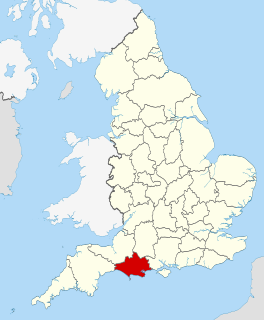
Dorset is a county in South West England on the English Channel coast. The ceremonial county comprises the unitary authority areas of Bournemouth, Christchurch and Poole and Dorset. Covering an area of 2,653 square kilometres (1,024 sq mi), Dorset borders Devon to the west, Somerset to the north-west, Wiltshire to the north-east, and Hampshire to the east. The county town is Dorchester which is in the south. After the reorganisation of local government in 1974, the county's border was extended eastward to incorporate the Hampshire towns of Bournemouth and Christchurch. Around half of the population lives in the South East Dorset conurbation, while the rest of the county is largely rural with a low population density.

Bournemouth is a coastal resort town on the south coast of England. At the 2011 census, the town had a population of 183,491, making it the largest in the administrative county of Dorset. With Poole to the west and Christchurch in the east, Bournemouth is part of the South East Dorset conurbation, which has a population of 465,000.

Christchurch is a town and civil parish in Dorset on the south coast of England. The town covers an area of 19.5 square miles (51 km2) and had a population of 48,368 in 2013. It adjoins Bournemouth to the west, with the New Forest to the east. Part of the historic county of Hampshire, Christchurch was a borough within the administrative county of Dorset from 1974 until 2019, when it became part of the new Bournemouth, Christchurch and Poole unitary authority.

Poole is a large coastal town and seaport in Dorset, on the south coast of England. The town is 21 miles (34 km) east of Dorchester and adjoins Bournemouth to the east. Since 1 April 2019, the local authority is Bournemouth, Christchurch and Poole Council which is a unitary authority. Poole had an estimated population of 151,500 making it the second-largest town in the ceremonial county of Dorset. Together with Bournemouth and Christchurch, the conurbation has a total population of nearly 400,000.

Brownsea Island, also archaically known as Branksea, is the largest of the islands in Poole Harbour in the county of Dorset, England. The island is owned by the National Trust with the northern half managed by the Dorset Wildlife Trust. Much of the island is open to the public and includes areas of woodland and heath with a wide variety of wildlife, together with cliff top views across Poole Harbour and the Isle of Purbeck.

Sandbanks is a small peninsula or spit crossing the mouth of Poole Harbour on the English Channel coast at Poole in Dorset, England. It is known for its high property prices and for its award-winning beach. In 2005 Sandbanks was reported to have the fourth highest land value by area in the world. The Sandbanks and Canford Cliffs Coastline area has been dubbed "Britain's Palm Beach".

Dorset is a rural county in south west England. Its archaeology documents much of the history of southern England.

Isaac Gulliver (1745–1822) was an English smuggler based on the South Coast. Gulliver and his gang ran fifteen luggers to transport gin, silk, lace and tea from the Continent to Poole Bay and came to control the coast from Lymington on The Solent in Hampshire, through Dorset to Torbay in Devon. He was known as "King of the Dorset Smugglers" and was also referred to as "the gentle smuggler who never killed a man". His men, who whitened their hair and wore smock-frocks, were known as the "white-wigs".
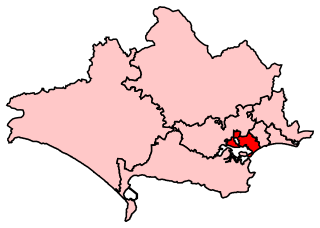
Poole is a constituency represented in the House of Commons of the UK Parliament since 1997 by Robert Syms, a Conservative.
The Hawkhurst Gang was a notorious criminal organisation involved in smuggling throughout southeast England from 1735 until 1749. One of the more infamous gangs of the early 18th century, they extended their influence from Hawkhurst, their base in Kent, along the South coast, to Dorset, where they successfully raided the customs house at Poole. After they were defeated in a battle with the Goudhurst militia in 1747, two of their leaders, Arthur Gray and Thomas Kingsmill, were executed in 1748 and 1749.

The History of Bournemouth and human settlement in the surrounding area goes back for thousands of years.
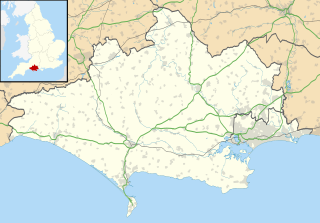
Mudeford is a harbourside and beach-side parish based on an ex-fishing village in the east of Christchurch, Dorset, England, fronting water on two sides: Christchurch Harbour and the sands of Avon Beach.
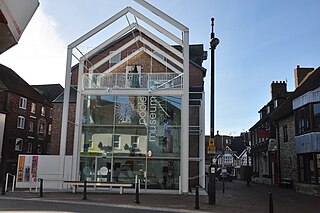
Poole Museum is a local history museum situated on the Lower High Street in the Old Town area of Poole, Dorset, and is part of the Borough of Poole Museum Service. Entrance to Poole Museum is free, and the museum is the fifth most visited free attraction in South West England.
Henry Paye, also known as Harry, Page or Arripaye, was a privateer and smuggler from Poole, Dorset in the late 14th and early 15th century, who became a commander in the Cinque Ports fleet.
The history of Poole, a town in Dorset, England, can be traced back to the founding of a settlement around Poole Harbour during the Iron Age. The town now known as Poole was founded on a small peninsula to the north of the harbour. Poole experienced rapid growth as it became an important port following the Norman Conquest of England.
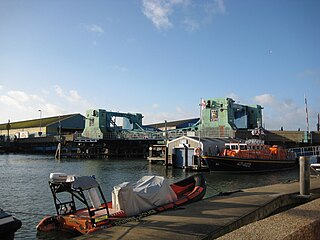
Poole Bridge is a bascule bridge in Poole, Dorset, England. Constructed in 1927, the bridge provides a road link across a busy boating channel. In February 2012 a second bridge was completed intending to operate in conjunction with the existing bridge

Christchurch is a town, civil parish and former borough in the county of Dorset on the English Channel coast, adjoining Bournemouth in the west, with the New Forest to the east. Historically in Hampshire, it joined Dorset with the reorganisation of local government in 1974 and is the most easterly borough in the county. The town has existed since 650 AD and its close proximity to the Cotentin Peninsula made it an important trading port and a potential target for invasion during the Napoleonic and Second World Wars.

Scaplen's Court is a fifteenth century Grade I listed house in Poole, Dorset, England, adjacent to the Poole Museum. The house is now used as a museum focusing on life in Poole between the fifteenth and nineteenth centuries, and includes a Victorian schoolroom and kitchen.

Thomas Kingsmill was one of the leaders of the notorious Hawkhurst Gang of smugglers that operated, from its base in Kent, along the South Coast of England from 1735 until 1749. One of the more infamous gangs of the early 18th century, they extended their influence from Hawkhurst, their base in Kent, along the South coast, to Dorset.
The economy of Dorset in South West England was worth £16.189 billion to the UK economy in 2013.


















